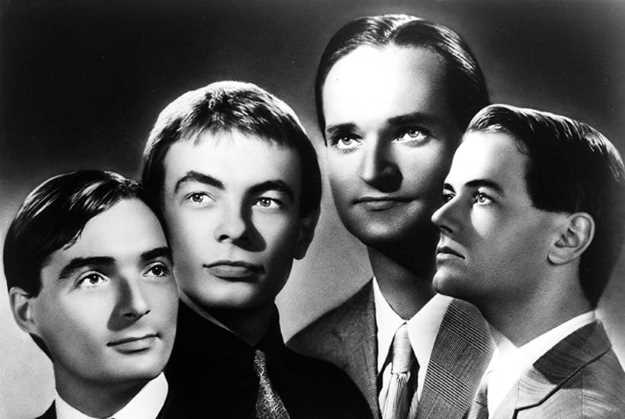| |
Taken from The Spectator (Feb 20, 2020)
Why were Kraftwerk such a colossal success?
Everything about the robot-pop group was odd: they had no front man, they seemed to play no instruments and they dressed like accountants in suits and ties
by Jay Elwes

Kraftwerk, photographed in 1975. Credit: Getty Images |
Kraftwerk:
Future Music from Germany
Uwe Schuette
Penguin, pp.317, £9.99 |
Everything about Kraftwerk was odd. They had no front man, they seemed to play no instruments and their strange, electronic music owed nothing to blues, soul or any of the other forms of music that underpinned 20th-century pop. Instead, a Kraftwerk gig consisted of four rather gauche-looking fellows from Duesseldorf standing in a row, each poking at a synthesiser, as a strange, apparently unconnected series of images appeared on screens behind them. A Kraftwerk album could be just as confounding. The cover of the 1977 album Trans Europe Express featured a portrait of the band. In suits and ties, they looked more like the partners at an accountancy firm than an electronica band.
Odd they may have been, but Kraftwerk were revelatory for being the first group in history to make purely electronic music and their sound - a torrent of synth sounds, drum machines and electronically mangled voices - was so different as to sound almost alien. Ralf Huetter and Florian Schneider, the founders of the band, who met in 1968, called their sound Industrielle Volkmusik, which David Bowie - a big fan - translated as 'folk music of the factories'.
Perhaps the most surprising thing of all about Kraftwerk was that they turned out to be such a colossal success. The Autobahn album, released in 1974, should by any reckoning have been a commercial disaster. Side one consisted of a single 22 minutes and 43 seconds track about the joy of German motorways. The cover art was, you've guessed it, a motorway sign. Almost unbelievably the album went to No. 5 in the US and stayed in the charts for more than four months.
Stranger still was the resonance that Kraftwerk's rather buttoned-up European style had with black communities in the US. The cross-over between Kraftwerk and hip hop is an intriguing one, that shines a revealing light on both strains of music. German artists in the post-war period were set on creating all-new forms of expression, in order to escape the shadow of the country's tainted history. In the same way, black American artists were also looking to move beyond a deeply troubled past. It was this search for the new that made Kraftwerk so appealing, not only to hip hop artists such as Afrika Bambaataa and Run DMC, but also to Prince, George Clinton and the producers of the enormously influential Detroit techno scene.
It was the Man-Machine album that won Kraftwerk their global reputation. It was a brilliantly conceived work, and included 'The Model', the hit single that went to No. 1 worldwide. It is also the album that presented the most famous image of the band, as a four-piece of strange, automaton-like figures, dressed identically in red shirts, black ties and dark trousers. It was a daring move for a German group to present itself as a cadre of robotic, uniformed young men dressed in black and red. The Nazi association was subtle, but unmistakable.
Of course, Kraftwerk had no Nazi sympathies at all. As much as it was a band, Kraftwerk was an intellectual project, an idea born of the conceptualist art movements of the 1960s and the flirtation with that forbidden imagery was a signal. First it was a warning of the dangers of conformity. But it was also an indication that the band dared to reach back into Germany's past for inspiration. As Huetter explained: 'Our roots were in the culture that was stopped by Hitler, the school of Bauhaus and German Expressionism.' Their ambition, then, was nothing less than a re-animation of German culture.
Their aim was to achieve this through the creation of what Wagner referred to as the Gesamtkunstwerk - the 'total work'. For Kraftwerk, the music, the album artwork, the graphics that accompanied the live performances, their outfits, the videos, all of it was part of the overall work. It was a lesson learned from Warhol, that 'pop culture and pop art had to transcend the dividing lines between the various art forms'.
To a certain extent they achieved that transcendence. But of all the divides they broke down, the most significant was that between musician and sound engineer. Kraftwerk invented the idea that it was not only a musical instrument that could be played - the studio itself could be an instrument. As such, in their synth-lined 'Kling Klang' studio (no visitors allowed) they became the first producer-artists of the electronic era, in a line that stretched from Quincy Jones via Dr Dre all the way through to the current proliferation of bedroom laptop wannabes.
As this strange, slightly jumbled, rather intense book notes, 'music is the movement of sound through time'. It's a good line. And as the music of the 20th century fades from our ears, Kraftwerk's sound is still moving.
|
|